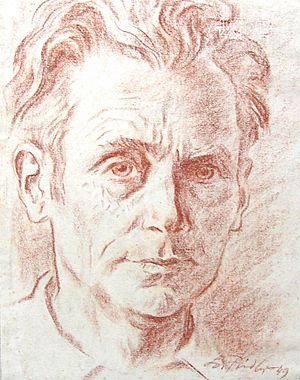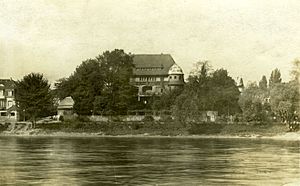Friedrich Kurt Fiedler facts for kids
Friedrich Kurt Fiedler (born March 8, 1894 – died November 11, 1950) was a German graphic designer and a member of the Social Democratic Party. During the Weimar Republic (a time in German history before the Nazis), he was well-known for his poster designs, book illustrations, and drawings. After World War II, he helped restart an art association in Dresden. However, he lost his influence when other political groups pushed out the social democrats.
Contents
Life
Early Years and Learning
Kurt Fiedler was born in a small village called Eichbusch, near Dresden. His father was a carpenter. Kurt's teacher noticed he was very talented. The teacher convinced his parents to let him study art after he finished elementary school.
Around 1910, he took evening classes at the Kunstgewerbeschule Dresden, an art school. He studied there with Hermann Glöckner, who later became a famous painter, and Edmund Schuchardt, an architect. This school helped students from humble backgrounds get an education. From 1911 to 1915, Fiedler received a special grant to study as a master's student under Richard Guhr and Josef Goller.
World War I and the Weimar Republic
During World War I, Fiedler served as a soldier on the front lines in France. He taught himself French and became a translator.
After 1920, Fiedler and his family moved into the Dürerbundhaus in Blasewitz. This building was a very important cultural center. Ferdinand Avenarius led the Dürerbund, a major cultural group for German-speaking countries, from this house. Living there helped Kurt Fiedler make important connections right away. He designed the main title for the social democratic newspaper Dresdner Volkszeitung.
The Nazi Period
When the Nazis took power, they immediately searched Kurt Fiedler's home. He and the house owners, Eva and Wolfgang Schumann, were known as active social democrats. The Schumanns had already left Germany.
Some of Fiedler's old clients were banned or faced difficulties. For example, the famous circus Sarrasani had problems. Fiedler made up for fewer contracts with publishers by doing advertising work for industrial companies. Just before the Jewish owners of Ilse Bergbau AG lost their company, Fiedler was hired to create an advertisement for their 50th anniversary.
In the early Nazi years, he still showed his art at some exhibitions. But instead of following Nazi art styles, Fiedler visited the 1937 World's Fair in Paris.
During World War II, Kurt Fiedler worked as a translator in prisoner of war camps. He left the army in 1942 because of political disagreements and poor health. After that, he earned money by making technical drawings at the Dresden University of Technology.
The Dürerbundhaus was completely destroyed during the terrible bombing of Dresden in World War II on February 13, 1945. Fiedler's sister-in-law, Fanny Schuchardt, lived next door. She used the chaos to hide. She was in danger because she was Jewish, and her forced transport to a concentration camp was planned for February 16. She was one of the very few Jewish people who survived The Holocaust in Dresden.
After the War
Kurt Fiedler and his family moved back to his childhood home in Eichbusch. He became a director of the association of fine arts in Dresden. He also worked as an artistic staff member for the Socialist Unity Party of Germany. However, like many social democrats, he slowly lost his influence.
Artwork
Book Illustrations
Fiedler was especially famous for his cover illustrations for the adventure story series Fahrten und Abenteuer (Travels and Adventures). This series was put together by the director of the Sarrasani circus. It's thought that this series, which had about 100 small books, sold a total of 10 million copies!
In 1926, Fiedler worked with Hermann Häfker to create an astronomy book called Das Sternbilder-Buch for the Dürerbund. Häfker later died in a concentration camp. The Dürerbund wanted to share knowledge and encourage a love for nature among young people. In the same year, Dresden was one of the first cities to get a projection planetarium. Fiedler was chosen to help promote it. He designed posters and newspaper ads, and he illustrated two books by the planetarium's director, Kurd Kisshauer.
Publishing houses like Steinkopff, Teubner, and Rudolph hired Fiedler to illustrate textbooks and bookplates (special labels for books). A book called Jüdische Witze (Jewish Jokes) was published in 1928 and 1930 under a fake name, "H. Itler." Today, no one knows who used this name, which was an ironic reference to the later Nazi dictator. Fiedler also designed many titles for Talisman-Bücherei, a popular series of books that were part of the New Thought movement. Some of these books were later banned by the Nazis.
Advertising and Drawings
Fiedler won an award at the World Advertising Congress in Berlin in 1929. After that, he became known for some of his drawings, especially those of children. His most important clients included the tourism industry, Villeroy & Boch, Dresden's first newspaper (the Dresdner Anzeiger), and the German Cycling Federation. For example, he designed a poster for the Dresdner Anzeiger's 200th anniversary in 1930.
Socialist Posters
Today, Fiedler is seen as one of the most important poster artists in East Germany after World War II. Many of his works are kept in major museums and archives, such as the Deutsches Historisches Museum and the German Federal Archive. One of his most famous posters from that time is Junkerland in Bauernhand, which he designed for the film company DEFA. This poster is even part of a permanent exhibition in the Haus der Geschichte in Bonn. The German national picture archive of arts has records of 34 of his posters from this period.
Mistaken Identity
For many years, Kurt Fiedler from Dresden was confused with another artist named Kurt Fiedler, an impressionist painter born in Berlin in 1878. Many of Dresden's Kurt Fiedler's works were wrongly linked to the Berlin artist. This mistake started in a 1930 art handbook, which mixed up the Dresden address with the life details of Berlin's Kurt Fiedler. This confusion then spread to other art books.
See also
- List of Social Democratic Party of Germany politicians
- List of German painters










